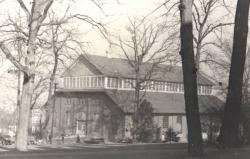
In 1907, John Fritz, known as the "Father of the Steel Industry in the United States," rejoined the Lehigh University Board of Trustees after an absence of a decade. He began the development of what would prove to be his greatest gift to Lehigh: a modern engineering laboratory and funding for its construction.
When completed in 1910, the Fritz Engineering Laboratory was the largest and best-equipped university laboratory of its type in the U.S. It was patterned after the shop buildings that Fritz had erected at the Bethlehem Iron Company. This type of building would provide proper space, good lighting, and logical arrangement for testing machines. It was divided into four separate work areas devoted to structural testing, cement testing, making and storing concrete test specimens, and hydraulic studies.
Facts
- The building was of modern steel framed construction, 114 feet in length and 90 feet in width. Its roof ridge was 56 feet above the surrounding ground. The laboratory framing was one of the first applications of wide-flange structural shapes, first rolled in the U.S. by the Grey Mill at Bethlehem Steel Company in 1908.
- The initial laboratory equipment, personally chosen by Fritz, represented the state-of-the-art in testing technology. There were twelve principal pieces of testing equipment, the most important of which was an 800,000-pound capacity Riehle universal testing machine. When installed, it was the largest vertical screw-driven universal testing machine in the U.S., capable of testing tension members up to 20 feet and compression members up to 25 feet in length.
- The total cost of the laboratory exceeded $50,000, to which Fritz subsequently added another $150,000 to serve as an endowment for continuing maintenance of the facility.
- Fritz Engineering Laboratory was the first university laboratory with a high bay and equipped with an overhead crane for moving the testing machines and for moving heavy materials to them.
- Extensive industrial testing during the period 1910-1930 facilitated the development of skyscrapers and major bridge structures.
- Experimental investigation of reinforced concrete columns in the 1930's conducted jointly by Lehigh University and the University of Illinois eventually resulted in the widespread adoption of the first modern ultimate strength procedures for the design of structural elements.
- Studies in the 1940s and '50s of the influence of residual stresses provided a major breakthrough in predicting the strength of steel columns and other structural members in which stability is the limit of usefulness. This information was essential to the later formulation of expanded, new design rules for steel structures.


